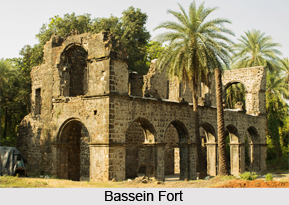 Bassein fort is of the well known sea forts of India which remained under the control of the Portuguese since 16th century. Located on Vasai road, this is the third last station of western railway. This is one of the oldest sights found in the suburban region of Mumbai. This historical sight falls in the Thane district located in the north of Mumbai. Though originally built by the Sultan of Gujarat it served as a main establishment for the Portuguese who captured and settled in this palace to observe Indian borders and movement of Indian army in their surroundings. Built in 1534 it worked as a centre of operation till 1739.The Portuguese decided to treat this fort as the main base which was surrounded by a number of small forts built on the small islands which now fall in the territory of Pakistan.
Bassein fort is of the well known sea forts of India which remained under the control of the Portuguese since 16th century. Located on Vasai road, this is the third last station of western railway. This is one of the oldest sights found in the suburban region of Mumbai. This historical sight falls in the Thane district located in the north of Mumbai. Though originally built by the Sultan of Gujarat it served as a main establishment for the Portuguese who captured and settled in this palace to observe Indian borders and movement of Indian army in their surroundings. Built in 1534 it worked as a centre of operation till 1739.The Portuguese decided to treat this fort as the main base which was surrounded by a number of small forts built on the small islands which now fall in the territory of Pakistan.
Bassein Fort is one of the popular historical sights of Maharashtra which was well known for its strategic location. While this remained under the rule of Portuguese for a very long time, it was captured by the Marathas in the 18th century. The fort was attacked by the Maratha army under Peshwa Baji Rao`s brother Chimaji Appa. Though mainly turned into a ruin the fort still retains some of the prominent looks which depict the fineness of its architecture that resembles with the architecture of the Portuguese.
The remnants of Bassein fort stands straight to face the Vasai creek. The fort is surrounded with a number of watch towers which were used to observe the movement of Indian army and Indian Rulers. The fort includes a number of buildings which have presently turned into ruins. Although there are a number of walls which stand straight to give an idea about the common layout of the fort. It includes some well preserved facades and a number of arches which got eroded with time. These arches are usually decorated with stone curvatures which have undergone a lot of erosion. However some of them still depict the sharp chisel marks. Along with this the fort also includes three chapels which are well maintained and decorated with arches and facades that depict the architecture of 17th century Portuguese churches. The last church also contains a well preserved barrel vaulted ceiling. With its unique architecture and natural building that surrounds the dilapidated structure of the Bassein fort, it is considered as a major sight for shooting bollywood movies. Movies like Josh, Khamoshi, and Ram Gopal Verma`s Aag has spotted this sight as a background. Besides this the fort is often surrounded with colorful butterflies, migratory birds, plants and reptiles which are found in and around the palace.
Bassein fort which is also known as Vasai fort has been recently taken over by the archaeological survey of India who has started the restoration work of the fort. The work of renovation has been organized with local contractors. There are some illegal enclosures as well which is now being removed. Located in a slightly barren area this palace has been the centre of some unlawful activities as well which restricts the free movement of the tourists who visit the fort.
Thus located in the suburban regions of Mumbai this fort is well connected with western railway that leaves from Churchgate station. This place is largely connected with Dadar and Vihar which are two most prominent station of Mumbai. This place is also connected with bus services as well. One can reach the place with auto rickshaws as well. Overall this historical sight is considered as one of the major tourist spots that attract large number tourists from far off areas.



















